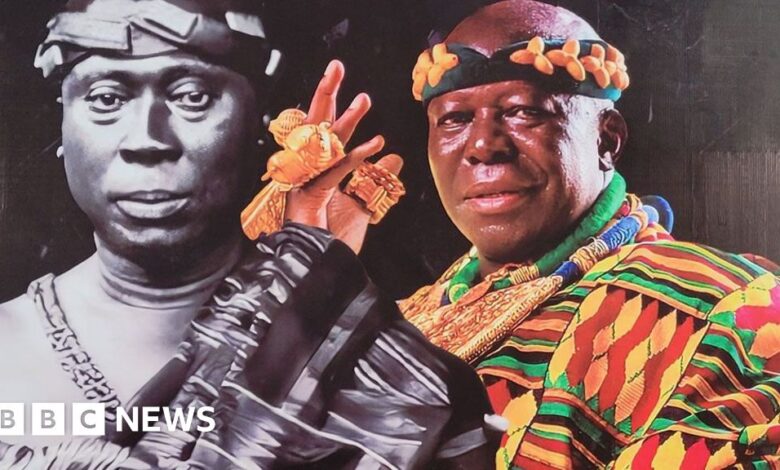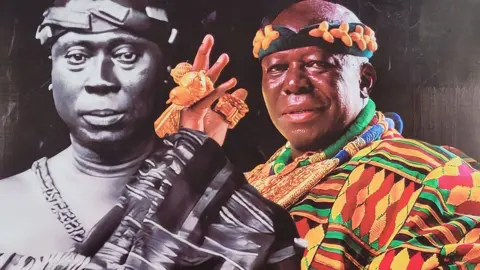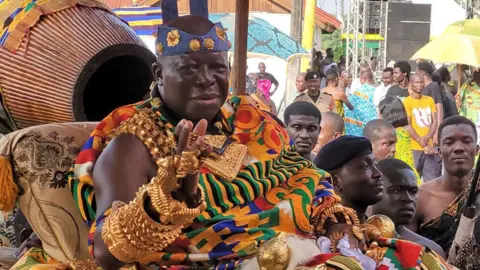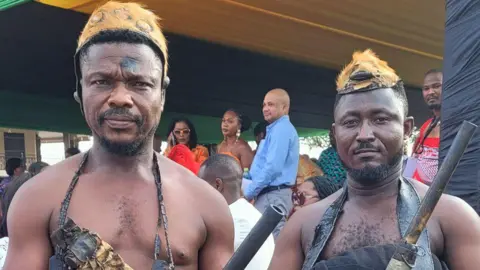Commemorates the king who was banished to Seychelles by the British

 Barnaby Phillips
Barnaby PhillipsThe field outside the royal palace in the Ghanaian city of Kumasi was filled with exuberant crowds, celebrating the return 100 years ago of an exiled king.
Prempeh was the Asante, or “Asantehene”, king of the late 19th century who resisted British demands that his territory be absorbed into the expanding Gold Coast protectorate.
A British army from the coast marched about 200km (124 miles) to Kumasi in 1896, took Prempeh and about 50 of his relatives, chiefs and servants prisoner, then looted his palace.
Prisoners were taken to the coastal fort at Elmina, before being transported to Sierra Leone, and in 1900, to the remote Seychelles islands in the Indian Ocean.
It was not until 1924 that the British allowed Prempeh to return home, by which time he was an old man who arrived in Kumasi wearing a European-style suit and hat.
It is a tragic story but also a story of pride and resistance.
“The British did all they could but they could not break the spirit of Asante,” the master of ceremonies shouted. The current Asantehene, Osei Tutu II, is paraded on a palanquin through the crowds, weighed down by sumptuous gold jewelry, amid a glorious symphony of musket blasts, drumbeats and trumpet blasts from ivory.
Asante culture still exists and thrives.
 Barnaby Phillips
Barnaby PhillipsBut Prempeh’s exile had a lasting impact on both the Asante kingdom and the Seychelles, although perhaps not in the way that British officials at the time intended.
The guest of honor at the centenary celebrations held in Kumasi at the weekend was Seychelles President Wavel Ramkalawan, who said it was “an honor, though sad, for us to receive the great king of the Friend”.
“He showed respect to our people and in return received the full love of the people of Seychelles,” Ramkalawan added.
Proof of that is the family relationship that is treasured to this day.
Princess Mary Prempeh Marimba is Prempeh’s great-granddaughter. Her grandfather, Prempeh’s son James, married a Seychellois woman and initially remained in the islands after his father left.
Mary is a nursing supervisor in the Seychelles capital Victoria and has traveled to Kumasi with her daughter Suzy to reunite with dozens of long-lost relatives and discover more about her Asante heritage.
“There are a lot of mixed emotions, my great-grandfather had a lot of trouble and this is a sad history, but I also come here and celebrate with my family,” she said.
The Asante exiles in Seychelles live in “Ashanti Town”, on a former sugar plantation, Le Rocher, on the main island of Mahé, overlooking the sea and surrounded by coconut, mango, breadfruit, orange and jackfruit trees .
According to Dr. Penda Choppy, a Seychellois scholar who also came to Kumasi for the centenary events, Prempeh lived in the estate’s villa and was given “every respect and dignity”.
In 1901, the Asante community grew when Yaa Asantewaa, the queen who led the final resistance against the British, and about 20 chiefs and servants, were also sent to the Seychelles after their surrender.
 Barnaby Phillips
Barnaby PhillipsThe long years of exile changed Prempeh. He learned to read and write, and encouraged Asante children to go to school.
He was a Christian, and in the words of historian and Asante politician Albert Adu Boahen, “rigidly and uncompromisingly imposed that religion on his fellow political prisoners and their children “.
In St Paul’s Anglican Cathedral, the Asante were not the only exiles in the congregation, as they often sat with King Mwanga of Buganda and King Kabalega of Bunyoro, both from modern-day Uganda.
Indeed, at various times, the British also sent political prisoners from Egypt, Palestine, Zanzibar, Maldives, Malaysia and Cyprus to Seychelles, which was known as a “prison without bars”, because of its segregation. Its establishment created a perfect position, for the British. perspective, to cause trouble for opponents.
As the years passed, Prempeh dreamed of going home.
In 1918, he wrote to King George V and begged to be allowed to return.
“See how miserable I was when I was taken prisoner… it has been 22 years and now it is painful to see my father, mother, brother and almost three-quarters of the chiefs dead. The remaining quarter, some blind, some languishing. grow old and the remaining people are attacked by various diseases,” Prempeh wrote.
A few years later, the British, perhaps knowing that Prempeh’s possible death in exile could cause political problems in Asante, finally relented.
In November 1924, Prempeh sailed back to West Africa with about 50 Asante companions, most of whom were born in the Seychelles.
A prominent local newspaper, The Gold Coast Leader, wrote: “We who do not know him are even more anxious to see his face.”
In Kumasi, many people slept next to the railway station to welcome him and, according to a British official, “a spectacle was presented by huge crowds…with white headbands denoting joy or war.” won, some laughed and cheered, while others cried with emotion.” , was a most touching and unforgettable scene.”
In theory, “Mr. Edward Prempeh” is now an ordinary citizen, but his people treat him as a king and gift him kingships, including the Golden Chair, which is said to contain the soul of Asante nation.
 Barnaby Phillips
Barnaby PhillipsPrempeh died in 1931, and his successor, Prempeh II, was reinstated as Asantehene in 1935.
Ivor Agyeman-Duah, an Asante scholar and director of the palace museum, helped organize the centenary celebrations.
They had even more personal significance, as his great-grandfather, Kwame Boatin, was one of the chiefs exiled with Prempeh.
But as Mr. Agyeman-Duah acknowledges, exile, with all its pain, also offers opportunity for those who endure it.
Kwame Boatin’s children went on to become ambassadors and leading civil servants, able to adapt to the dramatic changes that Asante, the Gold Coast and later independent Ghana, experienced in the 20th Century.
“Exiles have been exposed to the world and they have something to contribute,” he said. “What they brought back still inspires us, their dedication to scholarship and public service.”
In a village an hour’s drive from Kumasi, I met Princess Molly Prempeh, a vivacious lady in her 80s and Prempeh’s great-granddaughter.
“I’m the only person left here who was born in Seychelles,” she told me.
“I’m Seychellois and Ghanaian – I was five years old when I returned.”
In her old age, Molly reconnected with the beautiful islands where she was born and visited twice.
The Seychellois were delighted with “Old Creole”, which contained more French words, which she remembered from her childhood.
“When I walk down the street, they shout ‘Hey princess, how are you?’ ‘Princess, venez, venez, sidekick?’ (come, come, are you okay?) They are lovely people. They love the Prempeh people in Sesel (Seychelles).”
But Molly’s visits are also tinged with sadness. She visits the grave of her mother, Hugette, who brought Molly as a child to the Gold Coast in 1948.
Hugette then returned to Seychelles, where she eventually died.
The story goes that, even in her old age, she still liked to speak the Twi language that Prempeh himself had taught her as a child.
The story of one family’s loss, exile and suffering.
Barnaby Phillips is a former BBC journalist and author of Loot; England and the Benin Bronzes
Other BBC stories about Ghana:
 Getty Images/BBC
Getty Images/BBC




